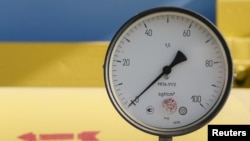The head of Ukraine's state-owned gas company, Naftogaz, dropped a bombshell this week, vowing that the country could stop buying gas from neighboring Russia as soon as early 2016 if Kyiv is not offered a better price.
Moscow and Kyiv have feuded intermittently over Russian supplies of natural gas and their transit to other parts of Europe. But Ukraine's desire for diversification of energy sources has gained urgency since Russia seized Crimea and began lending support to armed separatism in eastern Ukraine.
"We expect and hope that Russian gas sellers will be rational and propose competitive prices to us," Naftogaz CEO Andriy Kobolev told reporters in Kyiv on November 3. "If there is no such offer, we will be purchasing all gas from Europe."
Kobolev set a deadline of December to resolve the pricing issue for the first quarter of 2016. He added that in October, Ukraine and Europe were buying gas from Russia for $227 per 1,000 cubic meters.
Can Kyiv Go Cold Turkey?
While a dramatic pivot away from Russian gas may be easier said than done, factors in Ukraine's favor include falling energy demand as a result of the conflict in the east and a steep price hike to consumers that is already in the pipeline, in addition to increased diversification of gas suppliers.
Energy Minister Volodymyr Demchishin has said Ukraine needs around 19 billion cubic meters of gas in underground storage by the end of the year for the winter season. The country's underground gas-storage facility contains 17.1 billion cubic meters of gas, gas-pipeline operator Ukrtransgaz announced on November 2.
Russia has been accused in the past of using gas to apply political pressure on Kyiv, and has turned off the taps to Ukraine at least four times since 2005. One of the more bitter disputes, in 2009, caused a brief gas shutoff to European destinations farther west.
Despite their checkered energy past and diplomatic relations that are at all-time lows over Russia's actions in Ukraine, Kyiv is still hugely dependent on Russian energy sources.
Still, in July, Ukraine stopped buying Russian gas because Naftogaz and Russian energy giant Gazprom could not agree on prepayment for third-quarter deliveries.
In September, Gazprom, Naftogaz and mediators from the European Union -- which gets around one-third of its imported gas from Russia -- hammered out a deal for Gazprom to ship 2 billion cubic meters of gas to Ukraine beginning October 1 and ending March 31. Gazprom said it renewed gas deliveries to Ukraine on October 12 after receiving $234 million of the agreed-upon $500 million sum for October.
Reducing Demand?
But this week's statements by Kobolev suggest Ukraine won't need all that Russian gas.
One of the reasons is the fact Ukraine has "witnessed a massive decline" in demand for gas in the past two years, according to Georg Zachmann, an energy expert at the Brussels-based Bruegel think tank. "So it's now down to some 40 to 45 billion cubic meters per year, while it was nearly double that a decade ago," Zachmann says.
The drop is due in large part to the simmering conflict in eastern Ukraine, which has led to the loss of control -- at least temporarily -- of energy-hungry factories in Donbas, Ukraine's traditional industrial heartland.
Moreover, Zachmann explains, with Ukraine's economy still failing to produce positive growth, overall energy demand is down.
Officials in Kyiv are likely expecting domestic demand for gas to continue to drop as liberalized prices start to take a bigger bite out of household budgets.
"Gas prices have been increased by about fourfold this year, which means that households will see very steep gas-bill raises during this winter, and the expectation is, I think it is a reasonable expectation, is that households will do more to reduce their heating demand," Zachmann says.
While rising gas prices may be bad news for Ukrainian families, they could serve as an incentive to Ukrainian companies, namely Naftogaz, to drill for more gas in Ukraine. In the 1980s, Ukraine was producing some 80 billion cubic meters of gas -- enough to meet current demand -- but now that number is down to about 20 billion cubic meters, according to Zachmann.
Reversing The Gas
Ukraine may be using less gas, but what it is purchasing is increasingly coming from diversified sources in Europe -- although those shipments are still originating in Russia.
"In 2013, there were only a few billion cubic meters that Ukraine was able to import from mainly Poland and Hungary at the time. But then they built this kind of back loop, reverse gas capacity from Slovakia, which now, taken all together, will amount to more than 20 billion cubic meters per year," Zachmann says.
Opening up so-called reverse gas flows eastward was part of the EU's response to Gazprom's decision to cut supplies to Kyiv for six months in 2014 due to a row over pricing and following Moscow's forcible annexation of Crimea.
In September 2014, Slovakia upgraded a pipeline to supply reverse flows to Ukraine. The link runs from the Vojany power station near the Ukrainian border to the western Ukrainian town of Uzhgorod and has a capacity of 14.5 billion cubic meters per year.
Slovak pipeline operator Eustream has refused, however, to reverse gas flow to Ukraine from another of the four main pipelines that carry Russian gas to Europe, saying doing so would violate its contracts with Gazprom.
The conclusions of a two-year EU investigation published in April were that Gazprom was abusing its dominant positions in Poland, Hungary, and six other countries in Eastern Europe by building "artificial barriers" to obstruct gas flows.

